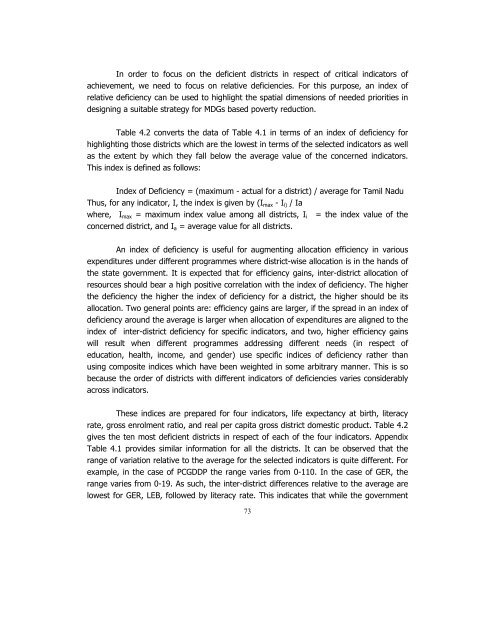POVERTY REDUCTION STRATEGY TN
Create successful ePaper yourself
Turn your PDF publications into a flip-book with our unique Google optimized e-Paper software.
In order to focus on the deficient districts in respect of critical indicators of<br />
achievement, we need to focus on relative deficiencies. For this purpose, an index of<br />
relative deficiency can be used to highlight the spatial dimensions of needed priorities in<br />
designing a suitable strategy for MDGs based poverty reduction.<br />
Table 4.2 converts the data of Table 4.1 in terms of an index of deficiency for<br />
highlighting those districts which are the lowest in terms of the selected indicators as well<br />
as the extent by which they fall below the average value of the concerned indicators.<br />
This index is defined as follows:<br />
Index of Deficiency = (maximum - actual for a district) / average for Tamil Nadu<br />
Thus, for any indicator, I, the index is given by (I max - I i) / Ia<br />
where, I max = maximum index value among all districts, I i = the index value of the<br />
concerned district, and I a = average value for all districts.<br />
An index of deficiency is useful for augmenting allocation efficiency in various<br />
expenditures under different programmes where district-wise allocation is in the hands of<br />
the state government. It is expected that for efficiency gains, inter-district allocation of<br />
resources should bear a high positive correlation with the index of deficiency. The higher<br />
the deficiency the higher the index of deficiency for a district, the higher should be its<br />
allocation. Two general points are: efficiency gains are larger, if the spread in an index of<br />
deficiency around the average is larger when allocation of expenditures are aligned to the<br />
index of inter-district deficiency for specific indicators, and two, higher efficiency gains<br />
will result when different programmes addressing different needs (in respect of<br />
education, health, income, and gender) use specific indices of deficiency rather than<br />
using composite indices which have been weighted in some arbitrary manner. This is so<br />
because the order of districts with different indicators of deficiencies varies considerably<br />
across indicators.<br />
These indices are prepared for four indicators, life expectancy at birth, literacy<br />
rate, gross enrolment ratio, and real per capita gross district domestic product. Table 4.2<br />
gives the ten most deficient districts in respect of each of the four indicators. Appendix<br />
Table 4.1 provides similar information for all the districts. It can be observed that the<br />
range of variation relative to the average for the selected indicators is quite different. For<br />
example, in the case of PCGDDP the range varies from 0-110. In the case of GER, the<br />
range varies from 0-19. As such, the inter-district differences relative to the average are<br />
lowest for GER, LEB, followed by literacy rate. This indicates that while the government<br />
73

















